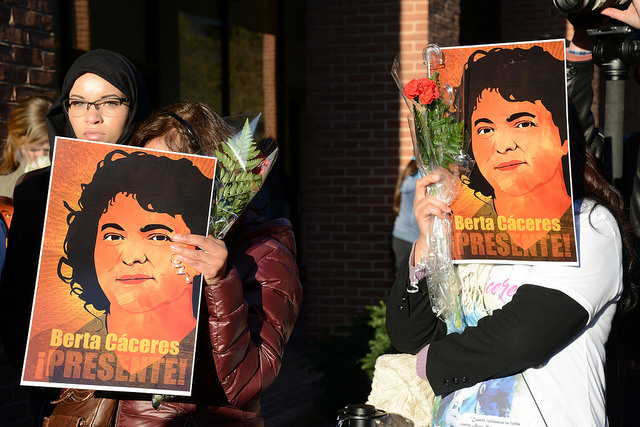The specter of death once embodied by government death squads of the 1980s has returned to defend the corporate power structure in Honduras.
A Renowned Activist, Assassinated
On March 3, 2016, Honduran human rights activist and coordinator of the Council of Indigenous and Popular Organizations of Honduras Berta Caceres was shot and killed in her home by unknown gunmen. Caceres was an internationally renowned environmental activist who organized indigenous communities to resist Chinese and European companies from constructing a hydroelectric dam on the Gualcarque river — a major source of water considered sacred by the Lenca people. Among many things, Caceres was a person who defended people from exploitation by energy companies. She was a high-profile victim of political violence that has already claimed the lives of more than 300 people and 22 environmental activists since 2012.
The news of her assassination reverberated throughout Latin America and I remember all the placards with her name and illustration when I took part in a march in recognition of International Women’s day in Los Angeles this year. From personal observation, her assassination was the topic of vigorous discussion among political activists and independent news outlets. Despite the proliferation of this unfortunate news, there seemed to be a lack of news coverage by large news agencies and the mainstream press. This news filtering and self-censorship is nothing new to scholars who have already documented this phenomenon in several well-known books and films. What also seldom received coverage was the 2009 U.S. backed-coup, which re-established much of the circumstances for the growing political violence in Honduras.
Political Violence
Political violence used to pacify the population into submission and silence environmentalists and individuals who challenge the status quo is nothing new to Honduras and the rest of Central and South America. Honduras was wracked with violence when U.S. corporations established the first “Banana Republic” in the country — a type of plantation economy. The plague of political violence became exacerbated when the U.S. funded the first death squads and right-wing paramilitary groups in the 1980s. The most infamous of these groups was Battalion 316 — a U.S. trained military unit infamous for carrying out political assassinations and extrajudicial killings.
Caceres was killed amidst the background of these events that took part mostly in the latter half of the twentieth century. Out of her death, news has started to trickle out of Honduras, including the return of these death squads and the military coup. Far from the danger brewing in the Central American country, news of the coup and increasing violence continues to garner traction in the United States. Infatuated with an election year, Democratic presidential hopeful, Hillary Clinton needs to acknowledge her support and involvement in the 2009 Honduran coup.
A Needed Voice
Greg Gandin, NYU history professor, writes in an article published in The Nation showing the connections between Caceres’ death and Clinton’s political machinations. Gandin declares the Clinton approved coup-government, “passed terrorist and intelligence laws that criminalized political protest.”
Caceres was a much needed voice on a planet suffering from anthropogenic climate change. It is time for the people to remember her legacy and continue the fight against all forms of oppression.







